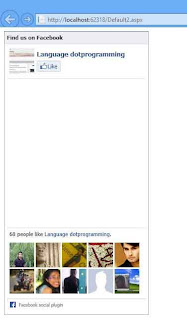Introduction of Literal control in ASP.NET:
The literal control is another Web Server control used for displaying text on a Web page, similar to that done by a Label control in ASP.NET , You can add HTML in a web page with the help of Literal control , without switching to the .aspx page. The Literal control exists within the System.Web.UI.WebControls namespace.
Public Properties of the Literal Class
Mode : Obtains or sets an enumeration value that specifies how the content in the Literal control is rendered.
Text : Obtains or sets the caption displayed in the Literal control.
Example of Literal control
How to use Facebook developer plugin using Literal control.
OutputThe literal control is another Web Server control used for displaying text on a Web page, similar to that done by a Label control in ASP.NET , You can add HTML in a web page with the help of Literal control , without switching to the .aspx page. The Literal control exists within the System.Web.UI.WebControls namespace.
Public Properties of the Literal Class
Mode : Obtains or sets an enumeration value that specifies how the content in the Literal control is rendered.
Text : Obtains or sets the caption displayed in the Literal control.
Example of Literal control
How to use Facebook developer plugin using Literal control.
<%@ Page Language="C#" %>
<!DOCTYPE html>
<script runat="server">
</script>
<html xmlns="http://www.w3.org/1999/xhtml">
<head runat="server">
<title></title>
</head>
<body>
<form id="form1" runat="server">
<div>
<asp:Literal ID="Literal1" runat="server" Mode ="Transform">
<div id="fb-root"></div>
<script>(function (d, s, id) {
var js, fjs = d.getElementsByTagName(s)[0];
if (d.getElementById(id)) return;
js = d.createElement(s); js.id = id;
js.src = "//connect.facebook.net/en_US/all.js#xfbml=1&appId=257965964247226";
fjs.parentNode.insertBefore(js, fjs);
}(document, 'script', 'facebook-jssdk'));</script>
<div class="fb-like-box" data-href="https://www.facebook.com/Dotprogramming?ref=hl" data-width="292" data-show-faces="true" data-stream="true" data-show-border="true" data-header="true"></div>
</asp:Literal>
</div>
</form>
</body>
</html>
<!DOCTYPE html>
<script runat="server">
</script>
<html xmlns="http://www.w3.org/1999/xhtml">
<head runat="server">
<title></title>
</head>
<body>
<form id="form1" runat="server">
<div>
<asp:Literal ID="Literal1" runat="server" Mode ="Transform">
<div id="fb-root"></div>
<script>(function (d, s, id) {
var js, fjs = d.getElementsByTagName(s)[0];
if (d.getElementById(id)) return;
js = d.createElement(s); js.id = id;
js.src = "//connect.facebook.net/en_US/all.js#xfbml=1&appId=257965964247226";
fjs.parentNode.insertBefore(js, fjs);
}(document, 'script', 'facebook-jssdk'));</script>
<div class="fb-like-box" data-href="https://www.facebook.com/Dotprogramming?ref=hl" data-width="292" data-show-faces="true" data-stream="true" data-show-border="true" data-header="true"></div>
</asp:Literal>
</div>
</form>
</body>
</html>
When you add a Literal control on a web page , The following code is added to the source code of the Web page.
<asp:Literal Id="Literal1" runat="server"></asp:Literal>
in above example mode property is set to Transform that convert your HTML tag into your HTML output.
simply you can say
<H1> Hello world </H1>
Transform enumeration property gives effect of the heading Tag
Output
Hello world

Tidak ada komentar:
Posting Komentar